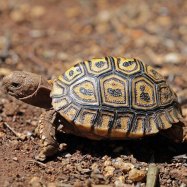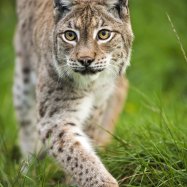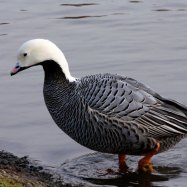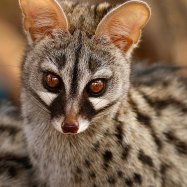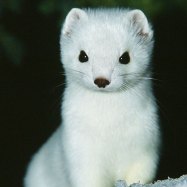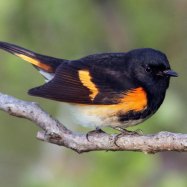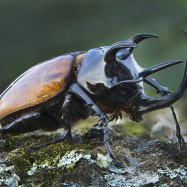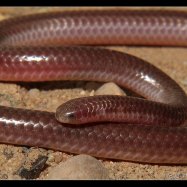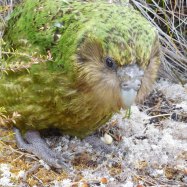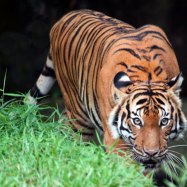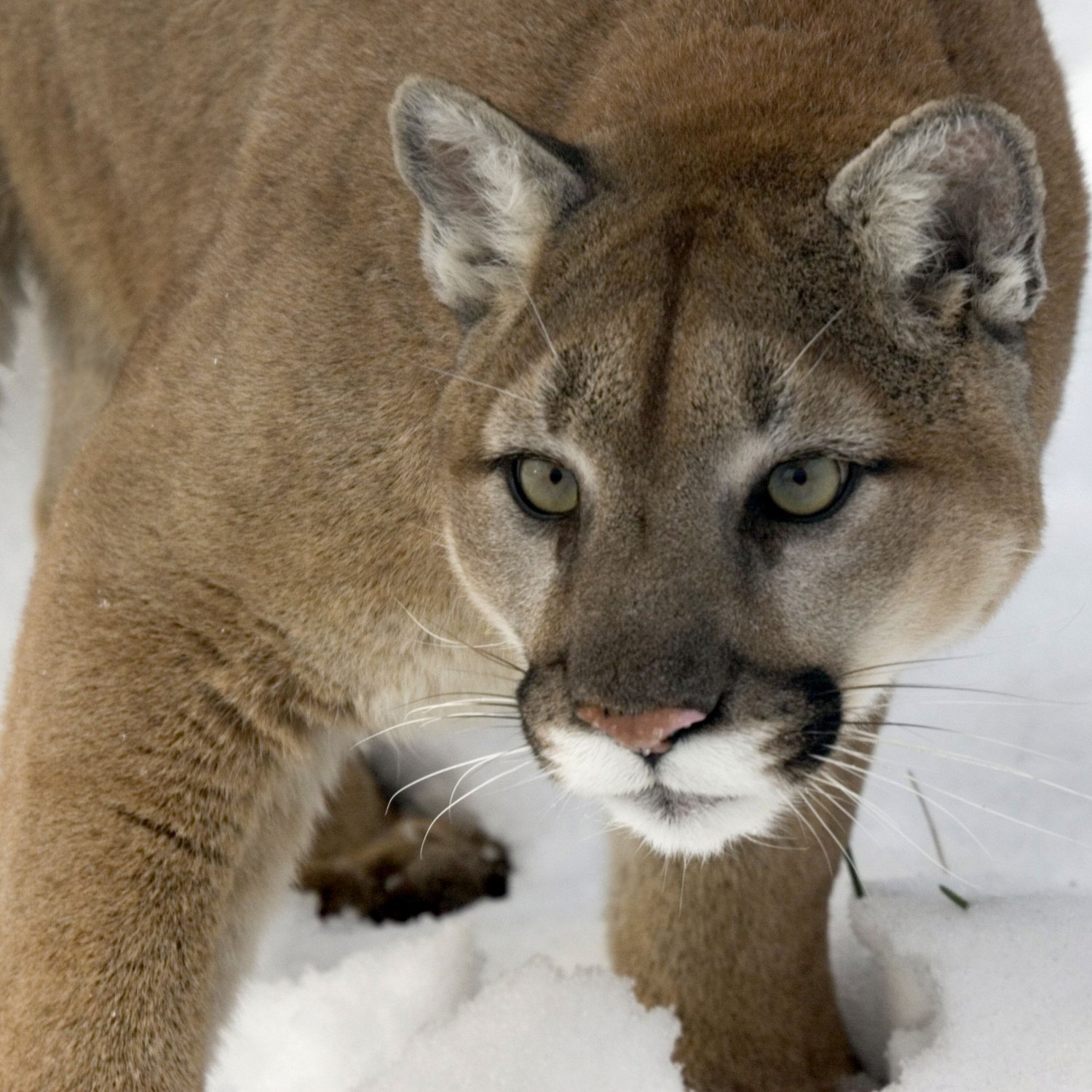
Cougar
5 to 9 feet
The cougar, also known as the mountain lion, is a fascinating animal found in North and South America. With a length of 5 to 9 feet and a muscular body, the cougar belongs to the Felidae family and is one of the strongest and agile members. Despite their powerful build, these beautiful creatures are elusive and prefer to roam alone in their habitat. #cougar #mountainlion #wildlife
Animal Details Summary:
Common Name: Cougar
Kingdom: Animalia
Habitat: Mountainous regions, forests, and deserts
The Majestic Cougar: A Fearless Predator of the Americas
As the sun sets over the vast mountains of North and South America, an apex predator stealthily prowls through the terrain. Its tan or brown fur blends perfectly with its surroundings, making it almost imperceptible. But make no mistake, this is the cougar, also known as the puma concolor, a fierce and powerful animal that roams in the wild.The scientific name of the cougar, Puma concolor, translates to "one color", reflecting its uniform coat color Cougar. But this magnificent creature is much more than just its outward appearance. With a kingdom of Animalia, a phylum of Chordata, and a class of Mammalia, the cougar belongs to the same family as the domestic cat – the Felidae family. But don't let its domestic cousins fool you, the cougar is a wild and formidable predator.
A Habitat Fit for a Cougar
The cougar's preferred terrain is as diverse as its geographical distribution. This animal can be found in a variety of habitats, including mountainous regions, forests, and even deserts. Its adaptability is a testament to its resilience and survival skills.Despite its ability to thrive in different environments, the cougar prefers to call the rocky, rugged landscape its home. The steep cliffs and rocky outcrops of the mountains provide the perfect vantage points for this predator to survey its surroundings and hunt its prey.
A Carnivore with a Varied Diet
As part of the order Carnivora, it's no surprise that the cougar is a carnivore Clownfish. Its diet consists mainly of large mammals such as deer, elk, and moose, but it is also known to feed on smaller animals like rabbits, rodents, and even insects. However, unlike most other wild cats, the cougar does not rely on speed to catch its prey. Instead, it uses its stealth, agility, and strength to hunt down its victims.The cougar is also a solitary animal, often preferring to hunt alone rather than in groups. This helps reduce competition for food and allows them to conserve energy. Cougars are also opportunistic hunters, which means they will take advantage of any prey that comes their way, making them a formidable opponent in the wild.
American Roots and Global Expansion
The cougar is native to the Americas and can be found in both the United States and South America. In fact, it is one of the most widely distributed mammals in North and South America, and its range extends from as far north as Canada, all the way down to the tip of South America.In the United States, the cougar can be found in various states, including California, Arizona, Texas, and Florida. However, they have also been spotted in other parts of the world, such as Canada, Mexico, and even Argentina. This geographic expansion is due to human intervention, as some cougars have been moved to other areas for conservation or hunting purposes.
The Controversy Surrounding Hunting
The cougar has been a source of much controversy in recent years, specifically in relation to hunting. While it is legal to hunt cougars in some states in the United States, other states have banned hunting this animal entirely. In Mexico and Argentina, cougars are also hunted for sport, causing a decline in their population.On the other hand, some argue that hunting is necessary for conservation and population control of the cougar. Cougars are a top predator in their ecosystems, and an uncontrolled population could have detrimental effects on other species. It's a delicate balance that authorities continue to monitor and regulate.
A Feline with Physical Prowess
The cougar, with its powerful body and muscular limbs, is a force to be reckoned with. Fully grown, it can reach a length of 5 to 9 feet and can weigh up to 200 pounds. Its hind legs are longer than its front legs, giving it a distinct body shape that is both athletic and powerful.Unlike most cats, the cougar cannot retract its claws, making them constantly visible. But this is more of an advantage for the cougar, as the claws give them a better grip and traction while running and climbing. This comes in handy when chasing down prey or scaling rocky cliffs.
The Hunt for Survival
The cougar exhibits some fascinating hunting behaviors that have been the subject of several studies. Their solitary nature makes them independent hunters, relying solely on their own skills to survive. They are also ambush predators, using their stealth and strength to surprise their prey, which they kill with a swift bite to the back of the neck.The cougar is also known for its stalking behavior, patiently observing its prey and waiting for the perfect opportunity to strike. They can be highly adaptable hunters, able to adjust their hunting style based on their environment and the availability of prey.
In addition to their impressive hunting techniques, cougars are also known for their incredible jumping abilities. They can clear distances of up to 40 feet in a single leap, which is vital when chasing prey in the wild.
A Life of Solitude
As mentioned earlier, cougars are solitary animals, and they are fiercely protective of their territory. They have an extensive range that can span up to 150 miles, and they will defend it from other cougars or any potential threats.Cougars are also known for their elusive nature, rarely spotted in the wild. They are most active at dawn and dusk, making them difficult to observe. However, with advancements in technology, scientists have been able to track and study their movements and behaviors, giving us a better understanding of these elusive creatures.
A Threatened Presence
Despite their adaptability and resilience, the cougar's population has faced significant decline in recent years. Human activities such as habitat destruction, hunting, and vehicle collisions have all contributed to their dwindling numbers. In some regions, cougars have lost most of their natural habitats due to urbanization and human encroachment.Conservation efforts are in place to protect the cougar and increase their population. In the United States, for example, they are listed as "least concern" on the International Union for Conservation of Nature (IUCN) Red List. However, continued efforts are necessary to ensure a healthy and sustainable population of this magnificent animal.
Promoting Coexistence with Cougars
Cougars play a crucial role in their ecosystem, helping to maintain a balance in their food chain. As top predators, they keep prey populations in check, which in turn impacts other species and their environments. Promoting coexistence with these animals is essential for the overall health and well-being of their habitats.If you live in an area where cougars reside, it's important to educate yourself and your family about living safely with these animals. Simple precautions, such as securing outdoor food and garbage, can help avoid potential conflicts. Additionally, reporting any cougar sightings or encounters to local authorities can help in monitoring their populations and ensuring their protection.
In Conclusion
From its physical prowess and solitary nature to its hunting abilities and adaptability, the cougar is a fascinating and resilient animal. Its presence in the Americas is vital for maintaining a healthy balance in the ecosystem. As humans, it's our responsibility to appreciate and protect this majestic creature, promoting coexistence and ensuring its survival for generations to come. The cougar may be a fierce predator, but it's also a critical part of our natural world, and we must learn to respect and appreciate its role in the wild.

Cougar
Animal Details Cougar - Scientific Name: Puma concolor
- Category: Animals C
- Scientific Name: Puma concolor
- Common Name: Cougar
- Kingdom: Animalia
- Phylum: Chordata
- Class: Mammalia
- Order: Carnivora
- Family: Felidae
- Habitat: Mountainous regions, forests, and deserts
- Feeding Method: Carnivorous
- Geographical Distribution: North and South America
- Country of Origin: United States of America
- Location: North and South America
- Animal Coloration: Tan or brown
- Body Shape: Athletic and powerful
- Length: 5 to 9 feet
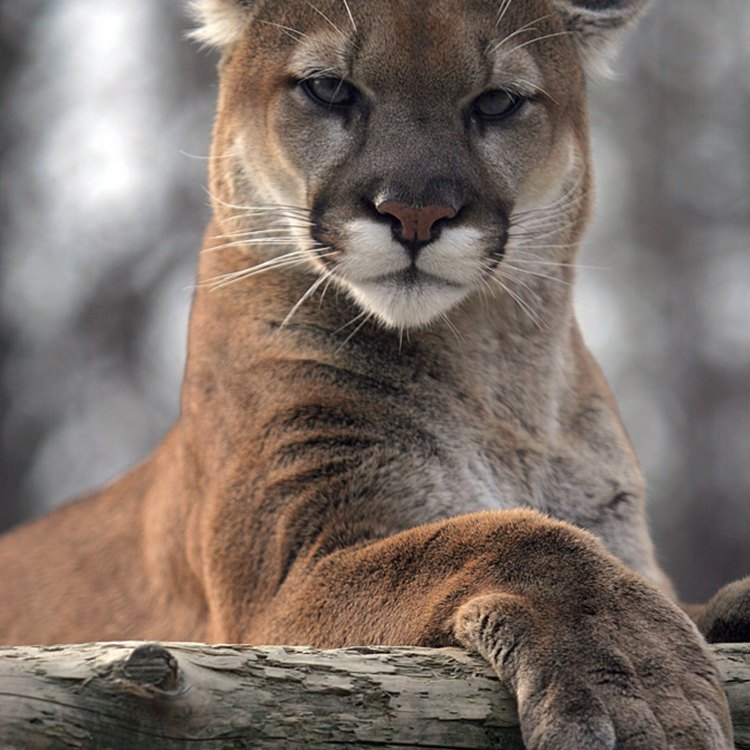
Cougar
- Adult Size: Up to 8 feet long
- Average Lifespan: 8 to 13 years
- Reproduction: Sexual
- Reproductive Behavior: Mating occurs throughout the year
- Sound or Call: Screams, roars, and purrs
- Migration Pattern: Nomadic
- Social Groups: Solitary
- Behavior: Territorial and elusive
- Threats: Habitat loss and fragmentation, hunting
- Conservation Status: Least Concern
- Impact on Ecosystem: Keystone species
- Human Use: Hunting and fur trade
- Distinctive Features: Powerful build and long tail
- Interesting Facts: Also known as mountain lion, puma, or panther
- Predator: No natural predator in its range
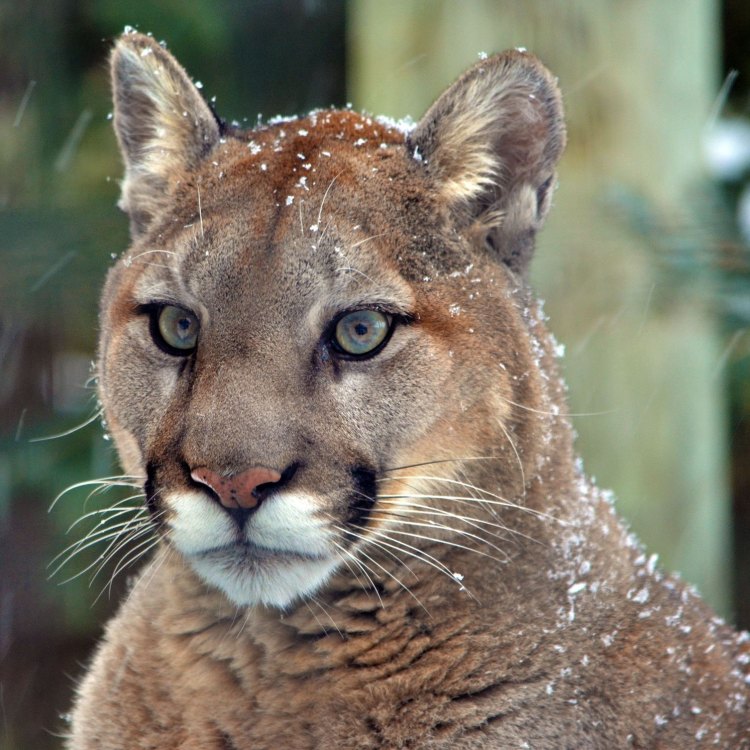
Puma concolor
The Elusive and Powerful Cougar: A Keystone Species That Defies the Odds
The cougar, also known as the mountain lion, puma, or panther, is a magnificent creature that has captured the human imagination for centuries. With its distinctive features, including its powerful build and long tail, the cougar stands out among the other members of the cat family. But there is more to this majestic creature than meets the eye. In this article, we will explore the unique features and fascinating behaviors of the cougar, as well as its impact on the ecosystem and its relationship with humans PeaceOfAnimals.Com.Let's start with the basics. The cougar is a large cat that can reach up to 8 feet in length, making it the second-largest cat in the Americas, after the jaguar. It can weigh up to 220 pounds and has a lifespan of 8 to 13 years. Its reproductive behavior is sexual, and mating occurs throughout the year, unlike some other animals that have a specific breeding season. This allows the cougar to have a flexible reproductive pattern and adapt to its environment more effortlessly.
One of the most distinctive features of the cougar is its call. This solitary cat is not very vocal, but when it does make a sound, it is often described as a "scream." Its range of vocalizations includes screams, roars, and purrs, which serve different purposes, such as communication, mating, and territorial defense. The screams of the cougar have been compared to those of a woman in distress, causing some to refer to it as the "ghost of the mountain Cedar Waxwing."
But it is not just its elusive nature and unique vocalizations that make the cougar stand out. Unlike other big cats, such as lions and cheetahs, the cougar doesn't live in a fixed territory. Instead, it has a nomadic migration pattern, which means it roams over a large area, searching for prey and suitable habitats. This makes it challenging to track and study the behavior of cougars in the wild, giving them a sense of mystery and intrigue.
Being solitary animals, cougars tend to avoid social groups and interactions. They are territorial and will fiercely defend their chosen hunting grounds from other predators and even other cougars. As elusive as they are, scientists have found that cougars have a complex social structure that includes interlacing territories that overlap with other individuals of the same gender. This unique behavior allows cougars to maintain their independence while still having a sense of community.
Unfortunately, the cougar faces a variety of threats in its natural habitat. One of the most significant threats is habitat loss and fragmentation due to human activities, such as urban development and deforestation. As a result, cougars are forced to compete for resources in smaller territories, leading to a decline in their population. Additionally, hunting and trapping for their fur have also contributed to the decline of cougar populations.
Despite these challenges, the cougar is currently classified as "Least Concern" on the International Union for Conservation of Nature (IUCN) Red List. This is because, as a keystone species, the cougar plays a vital role in maintaining the balance of the ecosystem. Keystone species are species that have a disproportionately large impact on the ecosystem compared to their numbers. Cougars, being the top predator in their range, help regulate the populations of their prey, such as deer and elk, which, in turn, helps to maintain the health of the ecosystem. Removing the cougar from this delicate balance can have cascading effects on the entire ecosystem.
But the impact of cougars on humans is not limited to their role in the ecosystem. Historically, cougars were hunted and trapped for their fur, which was prized for its softness and durability. Cougar hunting is still legal in some parts of the United States and Canada, with strict regulations in place to ensure the sustainability of the population. Additionally, there have been reports of cougars attacking and killing livestock, leading to conflicts with farmers and ranchers. These conflicts have resulted in the persecution of cougars and, in extreme cases, their extermination.
Despite human encroachment and conflicts, the cougar has managed to thrive and adapt in various habitats, including forests, mountains, and even suburban areas. Its well-honed hunting skills and ability to adapt to different environments have allowed it to survive despite the challenges it faces. The absence of a natural predator in its range also contributes to its resilience.
Before wrapping up, let's take a moment to explore some interesting and lesser-known facts about these elusive creatures. Did you know that cougars are excellent jumpers and can leap up to 18 feet in the air? This is why they are often referred to as "mountain lions." Cougars are also not related to lions at all and got their name due to their tawny color and similar appearance to the African big cat. Additionally, cougars are great swimmers and have been observed swimming in large bodies of water to hunt and cool off during summer months.
In conclusion, the cougar is a fascinating and resilient creature that has managed to survive in a changing world. With its elusive nature, unique behaviors, and indispensable role in the ecosystem, the cougar is a species that demands our respect and admiration. As humans, it is our responsibility to ensure the survival of this magnificent animal, not just for its sake but for the sake of our planet's health and balance. So, let us appreciate and protect this keystone species before it's too late.
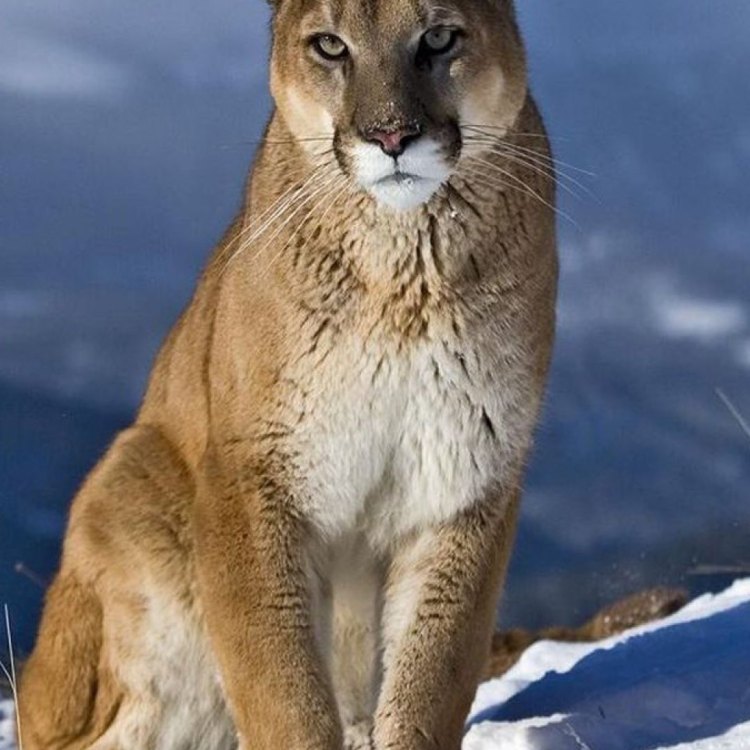
The Majestic Cougar: A Fearless Predator of the Americas
Disclaimer: The content provided is for informational purposes only. We cannot guarantee the accuracy of the information on this page 100%. All information provided here may change without prior notice.

